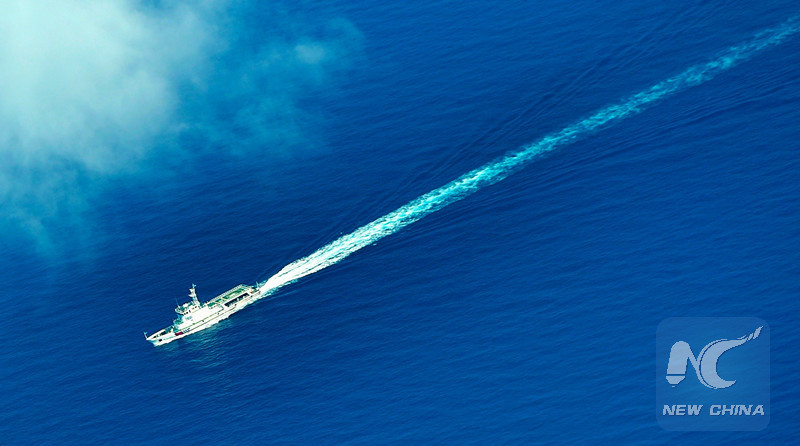The 33rd Summit of the Association of Southeast Asian Nations (ASEAN) and related gatherings have drawn to a close in Singapore. During his five-day stay in the city state, Chinese Premier Li Keqiang attended the 21st China-ASEAN (10+1) Leaders' Meeting, the 21st ASEAN-China, Japan and South Korea (10+3) Leaders' Meeting and the 13th East Asia Summit.
Fruitful results have been yielded from the meetings including the adoption of China-ASEAN Strategic Partnership Vision 2030 and the upgrade of the China-ASEAN free trade agreement protocol. And remarkable progress has been made in the negotiations on the Code of Conduct (COC) in the South China Sea as well as on the Regional Comprehensive Economic Partnership (RCEP).

Chinese Premier Li Keqiang poses for a group photo with leaders attending the 13th East Asia Summit in Singapore, on November 15, 2018. /Xinhua Photo
Chinese Premier Li Keqiang poses for a group photo with leaders attending the 13th East Asia Summit in Singapore, on November 15, 2018. /Xinhua Photo
China-ASEAN Strategic Partnership Vision 2030 adopted
The China-ASEAN Strategic Partnership Vision 2030 was approved on Wednesday at the 21st China-ASEAN (10+1) leaders' meeting held in Singapore, charting the course for their ties till 2030.
The document elaborates on China and ASEAN's consensus on overall bilateral relations and plans for political and security, economic and socio-cultural cooperation.
According to the vision, the two sides voiced firm opposition to the growing protectionist and anti-globalization sentiments and reaffirmed that international trade and investment are important engines for realizing sustainable economic growth, reducing social inequality, and securing a better life for people.

Chinese Premier Li Keqiang attends the 21st China-ASEAN (10+1) summit, which is also held to commemorate the 15th anniversary of the establishment of the China-ASEAN Strategic Partnership, in Singapore, November 14, 2018. /Xinhua Photo
Chinese Premier Li Keqiang attends the 21st China-ASEAN (10+1) summit, which is also held to commemorate the 15th anniversary of the establishment of the China-ASEAN Strategic Partnership, in Singapore, November 14, 2018. /Xinhua Photo
In the document, the two sides agreed to realize a goal of 1 trillion US dollars in two-way trade volume and 150 billion US dollars in investment by 2020. They also look forward to yielding more fruitful results from trade and investment by 2030.
Commenting on the vision, Phay Siphan, Cambodia's secretary of state and spokesman for the Council of Ministers, said the vision is a concrete roadmap for both sides to work together to build a closer community with a shared future
He stressed that the China-ASEAN strategic partnership “should serve as a model for countries all over the world.”
China-ASEAN FTA protocol upgraded
China and the ASEAN have upgraded the protocol of their free trade agreement to build the largest free trade zone among developing countries.
All domestic approvals for the upgrade were completed by Tuesday, Premier Li said at the 21st China-ASEAN leaders' meeting.

A frame crane transits a container from a truck to a freight train of the China-Singapore rail-sea transit route at a station in southwest China's Chongqing, September 25, 2018. /Xinhua Photo
A frame crane transits a container from a truck to a freight train of the China-Singapore rail-sea transit route at a station in southwest China's Chongqing, September 25, 2018. /Xinhua Photo
The FTZ further elevates the trade partnership between China and ASEAN members and sends a clear signal of safeguarding multilateralism and free trade, the premier said.
Philippine President Rodrigo Duterte said the protocol on upgrading the China-ASEAN FTA showed the two sides have been continuously promoting trade liberalization and investment facilitation.
"We believe that China and ASEAN can continue to promote trade and investment cooperation and maintain multilateralism, which remain our common interests,” Duterte said.
Malaysian Prime Minister Mahathir Mohamad said trade is very crucial to China and ASEAN, adding he hoped to continue to keep communications with China and tap trade potential.
China hopes to complete talks on South China Sea COC in 3 years
Meanwhile, China and ASEAN members agreed on Wednesday to reach a code of conduct over the South China Sea as soon as possible in order to properly manage differences, expand maritime cooperation and maintain stability.

Cruise vessel Haixun 1103 heads to the Yacheng 13-1 drilling rig during a patrol in the South China Sea, September 25, 2015. /Xinhua Photo
Cruise vessel Haixun 1103 heads to the Yacheng 13-1 drilling rig during a patrol in the South China Sea, September 25, 2015. /Xinhua Photo
Premier Li said the two sides have set an example of properly managing differences by fully implementing the Declaration on the Conduct of Parties in the South China Sea to ensure stability in the region. A single draft document for consultation has been reached for the code of conduct negotiations and the first round of reviews will be completed next year, the Premier said.
China is willing to work with ASEAN countries to conclude the negotiations within three years and believes countries within the region have the wisdom to ensure peace and stability in the South China Sea, he said.
The premier said at the East Asia Summit that China hopes countries outside the region to respect and support the efforts in this regard made by their counterparts in the region.
'Finishing kick' of RCEP talks
Premier Li also called on parties involved in talks on a new Asia-Pacific free trade pact to keep up with their efforts so as to clinch the deal next year.
Talks on the RCEP have reached the final stage, Li said in the 2nd leaders' meeting on RCEP on Wednesday.
"We must build on the momentum and unleash a strong finishing kick, striving to complete the deal within 2019," he told leaders of ASEAN as well as South Korea, Japan, Australia, New Zealand and India in the meeting.
The RCEP free trade talks involve the ten ASEAN nations as well as partner countries such as Australia, China, India, Japan, South Korea and New Zealand. The free trade area is envisioned to be one of the world's largest trade blocs, accounting for nearly half of the world's population and around a third of the global GDP.
Leaders at the East Asia Summit also pledged to speed up RCEP negotiations and enhance trade and investment liberalization and facilitation in the region.
With the ASEAN summit coming to conclusion, the focus will now shift to APEC and the G20 summits to be held later this month.
(With inputs from Xinhua, Gov.cn)






